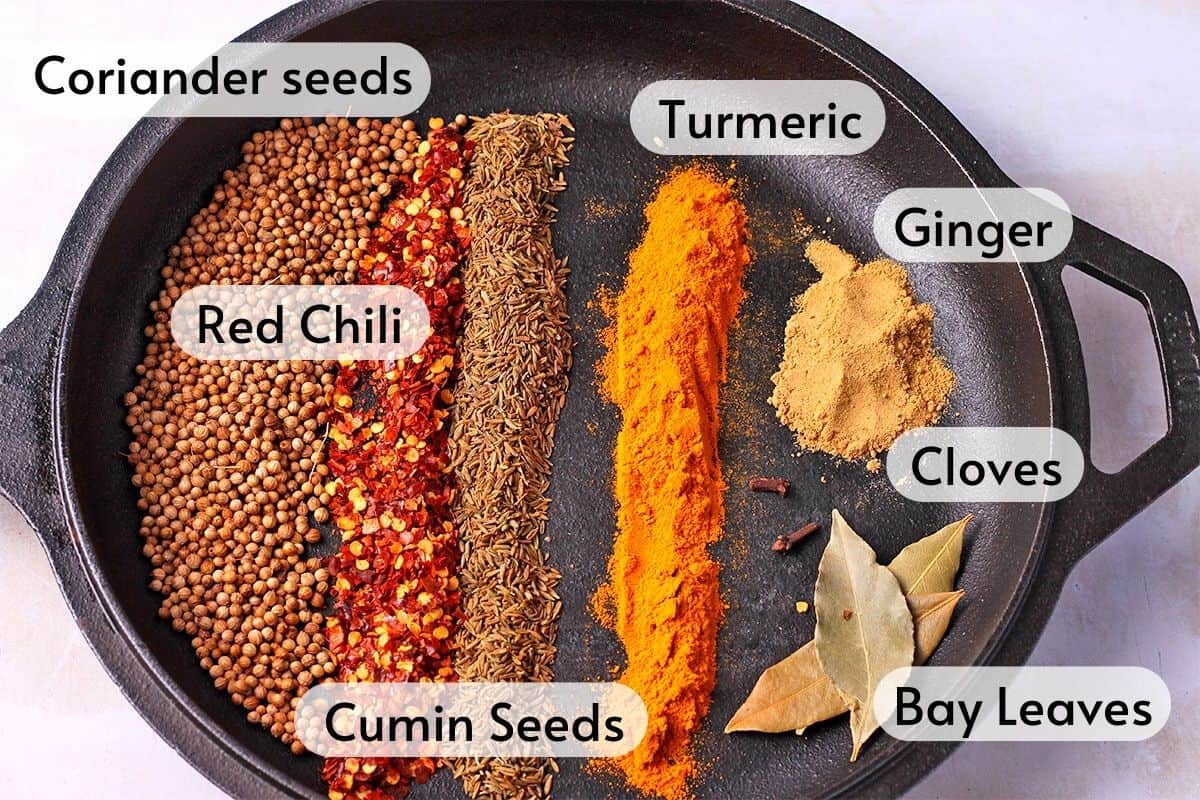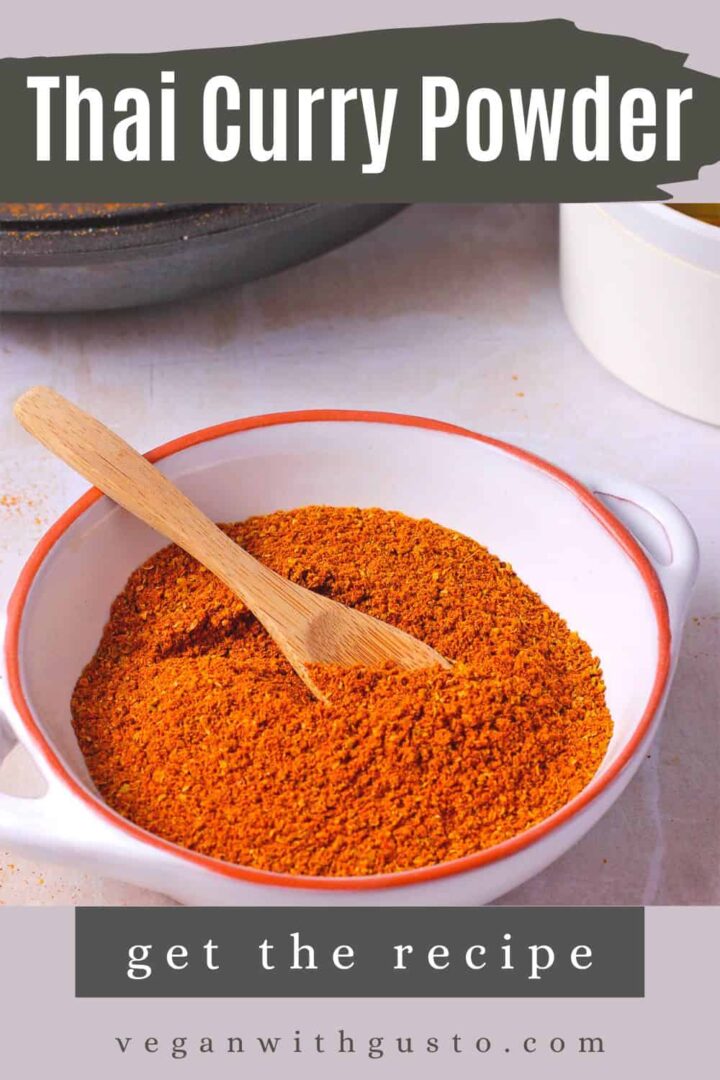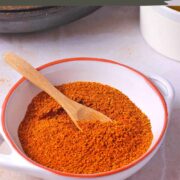This easy Thai curry powder recipe is bold and aromatic, rivaling the flavor of curry paste in a convenient and inexpensive vegan dry spice blend that lasts for years.

Regional spice blends create signature dishes with distinctive flavors; we are transported to different places through food.
When we eat Indian cuisine, we can easily recognize garam masala or curry powder. Za’atar or Bharat tells our noses we are headed to the Middle East. Spicy Berber mix signals Ethiopia, and my Mexican chili powder recipe is a staple.
If you’ve never heard of Thai curry powder, doesn’t it make sense that there’d be a blend of spices for that? Now we’re talking!
Table of Contents
⭐ Why You'll Love This Recipe
Don't get me wrong. Thai red curry paste and mellow Massaman curry paste are stellar. But they take time and fresh ingredients.
Rather than searching for a vegan curry paste without shrimp paste or fish sauce, making a comparable spice mix is easier. And that's without considering the limited shelf-life and the oil used to extend it.
This curry powder recipe changes all that. It’s easy to make with 7 spices and eliminates all the searching or shelling out for a paste that suits your dietary needs and lasts forever.
Finally, homemade blends are always better than store-bought curry powder because you control factors like salt and spiciness. When you make your own curry powder, you can make it as spicy as you like. Additional ingredients like sea salt or black pepper aren't off the table. This is all yours!
📋 Ingredients, Notes, and Substitutions

Coriander seeds. Coriander seeds have a fresher, more aromatic taste, and you can toast them for even more flavor. If you need to add ground spices, use a ratio of 1 whole to ¾ ground.
Cumin seeds. The smell of cumin seeds toasting tells the house you are making something delicious. Earthy, slightly sweet, and unique. Use the same ratio of 1 whole to ¾ ground if you make a substitution.
Turmeric powder. It's a curry powder classic. Turmeric isn't just beautiful. It's earthy, bitter, and peppery. It's one of the common ingredients in curry powders.
Ground ginger. Ginger root is often used in Thai cuisine, but you want the dry spice for this blend. Fortunately, ground ginger is readily available in most grocery stores.
Dry red chili. I used crushed red chili (red chili flakes) because they are so handy for adding spicy heat to chili and other foods. You can also use a few whole dry red chiles. Toast them with the rest of the spices. Experiment a little so you get the level of heat right.
Bay Leaves. The flavor of bay leaves activates when they meet liquid. Then an earthy, slightly minty taste emerges. If you have access to them, you can also dry lime leaves or a curry leaf, but bay leaves fit the bill and are more readily available.
Whole cloves. Use 2 whole cloves. That's it. Otherwise, cloves can take over with their slightly spicy flavor and sweetness. That rule of 1 to ¾ holds here. Use a pinch, less than ⅛ of a teaspoon, if you use ground cloves.
Please see the recipe card at the bottom of this post for the complete list of ingredients with measurements plus recipe instructions.
🔪 Instructions and Pro Tips

Before you begin, check each spice's dates before you use it. Dry herbs and spices lose their potency over time. Your homemade spice blend will always be as fresh as the oldest spice you use.
Use a heavy-bottomed pan over medium heat to toast the spices. Just toss them all in the pan and stir them constantly. After about 1 minute, you’ll smell the coriander and cumin. That’s your signal. Take them off the heat.
Note: If you use a pan like a cast iron that holds the heat, transfer the spices immediately. Otherwise, they will continue to toast. Burnt spices won’t win hearts, minds, or palates.

Transfer the spices to a spice grinder and pulverize them into a fine powder. If you use a coffee grinder, clean it before and after. Coffee is delicious, but not in Thai curry. And vice versa.
🍛 Serving Suggestions

Use 1-2 tablespoons of curry powder in sauces or Thai curries to replace, or in small amounts, to enhance curry paste when making Thai food. Start with a little and add more as you continue cooking. The flavor will build as the spices rehydrate. Wait to add more until you stir in vegetable broth, soy sauce, or coconut milk. Even small additions like lime zest, lemon juice, or lemongrass paste can have an impact.
Thai curry powder can replace your more common Indian seasoning blend. A little Thai-style makeover for some of your favorite recipes.
🌡️ Storage & Freezing
Store homemade curry powder in an airtight container, such as a jar with a lid. It’s always best to keep spices in a dry, dark place, away from the stove or oven heat.
You can also freeze spices in small portions to keep them fresh for longer. This is helpful if you have whole spices that you infrequently use.
💭 Frequently Asked Questions
The variations of curry powders are endless, but Thai curry powder and Indian curry powders have different flavors. Thai curry powder has sweeter, more citrussy overtones. Indian curry powder is a more complicated mix. It includes ingredients like mustard seeds, fenugreek, fennel seed, black or white pepper, cinnamon, and allspice, that add a distinctive taste to Indian recipes.
Curry paste has a different flavor profile, depending on the kind you use. It has fresh ginger, garlic, and, usually, lemongrass. For this reason, the substitution won't be 1 to 1. Start with 1 tablespoon of curry powder and build from there as you add other ingredients to your Thai curries.
Although store-bought curry powder will taste different from the same homemade and may not have the exact makeup of spices as this recipe, it's possible to buy it. Look for curry powder at supermarkets with a large selection of ethnic foods. You can also purchase it online, at specialty shops, or at an Asian grocery store.
📖 Thai-inspired Recipes
Do you have a question or recipe request or need a cooking tip? Leave a comment below or contact Denise. I’m here to help! If you want more healthy vegan recipes, please subscribe to my newsletter or follow me on Facebook or Pinterest for the latest updates.
If you make this recipe, please leave a ⭐⭐⭐⭐⭐ rating. It’s much appreciated!
👩🏻🍳 Recipe

Easy Thai Curry Powder Recipe
Rate this Recipe:
Ingredients
- 3 tablespoons coriander seeds - 2¼ tablespoons ground
- 2 tablespoons cumin seeds - 1 ¼ tablespoons ground
- 1 tablespoon turmeric powder
- 2 teaspoons ground ginger
- 1 tablespoon red chili flakes - crushed red chili
- 3 medium bay leaves
- 2 whole cloves - small pinch of ground
Instructions
- Heat a skillet or frying pan to medium heat. Add all the spices and stir them constantly for 1-2 minutes until the cumin and coriander seeds become fragrant and slightly darker.
- Remove the spices from the heat and place them in a spice grinder. Pulverize the ingredients into a fine powder.
- Makes about 4 ½ tablespoons.
Video
Notes
- Fresh spices make fresh spice blends, so consider the age of each ingredient to determine how long the curry powder will keep at full potency.
- If you use a coffee grinder, thoroughly wash it before and after use. We love Thai curry powder – but not in our morning coffee.
- Use 1-2 tablespoons of curry powder in sauces or Thai curries to replace, or in small amounts, to enhance curry paste when making Thai food.
- Store homemade curry powder in an airtight container, such as a jar with a lid. It’s always best to keep spices in a dry, dark place, away from the stove or oven heat.
- You can also freeze spices in small portions to keep them fresh for longer. This is helpful if you have whole spices that you infrequently use.
Nutrition
Nutritional information is an estimation only.























Leave a Reply